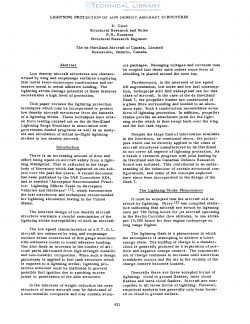F. Cicci – Lightning Protection of Low Density Aircraft Structures
- Version
- 288 Downloads
- 3.49 MB File Size
- 1 File Count
- March 5, 2017 Create Date
- March 5, 2017 Last Updated
Lightning Protection of Low Density Aircraft Structures

Ab str act Low density aircraft structures are charact— erized by wing and empennage surfaces employing thin rnetal semi—monocoque construction and ex— tensive metal to metal adhesive bonding. The lightning strike damage potential of these features necessitates a high Of protection. This paper reviews the lightning protection techniques which may be incorporated to protect low density aircraft structures from the hazards of a Lightning strike. These techniques have aris- en from testing carried out on the de Havilland Lightning Surge Simulator in association with government funded programs as well as an analy— sis and simulation of actual in-flight lightning strikes to low density aircraft. Introduction There is an increasing amount of time and effort being spent on aircraft safety from a light— ning standpoint. This is reflected in the large body Of literature which has appeared on the sub— ject over the past few years. A recent document has been published by the SAE Committee AE4, and is entitled "Aerospace Recommended Pract— ice: Lightning Effects Tests on Aerospace Vehicles and Hardware" ( l), which summarizes the test waveforms and techniques recommended for lightning simulation testing in the United The inherent design of low density aircraft structure warrants a careful examination of the lightning strike susceptibility of such an aircraft. The low characteristics of a S. T. O. aircraft are enhanced by Wing and surface areas constructed Of thin gauge aluminum with extensive metal to metal adhesive bonding. One also finds an increase in the number of air- craft parts fabricated from high strength metallic and non-metallic composites. When such a design is applied to fuel tank structure which is exB)Sed to a lightning strike, lightning pro— tective schemes must be instituted to prevent possible fuel ignition due to Sparking across joints or penetration Of the skin structure. In the interests Of weight reduction the nose structure of some aircraft may be fabricated of a non-metallic composite and may contain avion—
| File | Action |
|---|---|
| Lightning Protection of Low Density Aircraft Structures.pdf | Download |

Comment On This Post